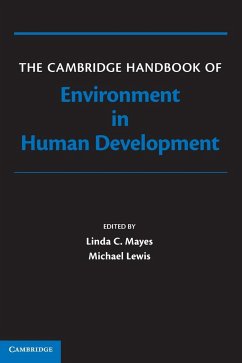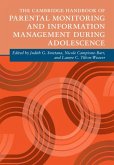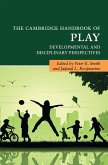The Cambridge Handbook of Environment in Human Development
Herausgeber: Mayes, Linda; Lewis, Michael
The Cambridge Handbook of Environment in Human Development
Herausgeber: Mayes, Linda; Lewis, Michael
- Gebundenes Buch
- Merkliste
- Auf die Merkliste
- Bewerten Bewerten
- Teilen
- Produkt teilen
- Produkterinnerung
- Produkterinnerung
This volume takes the child's environment (culture, education, family, peers and media) as an essential component of child development.
Andere Kunden interessierten sich auch für
![The Cambridge Handbook of Parental Monitoring and Information Management during Adolescence The Cambridge Handbook of Parental Monitoring and Information Management during Adolescence]() The Cambridge Handbook of Parental Monitoring and Information Management during Adolescence176,99 €
The Cambridge Handbook of Parental Monitoring and Information Management during Adolescence176,99 €![The Cambridge Handbook of Prosociality The Cambridge Handbook of Prosociality]() The Cambridge Handbook of Prosociality156,99 €
The Cambridge Handbook of Prosociality156,99 €![The Cambridge Handbook of Parenting The Cambridge Handbook of Parenting]() The Cambridge Handbook of Parenting179,99 €
The Cambridge Handbook of Parenting179,99 €![The Cambridge Handbook of Lifespan Development of Creativity The Cambridge Handbook of Lifespan Development of Creativity]() The Cambridge Handbook of Lifespan Development of Creativity185,99 €
The Cambridge Handbook of Lifespan Development of Creativity185,99 €![The Cambridge Handbook of Cultural-Historical Psychology The Cambridge Handbook of Cultural-Historical Psychology]() The Cambridge Handbook of Cultural-Historical Psychology70,99 €
The Cambridge Handbook of Cultural-Historical Psychology70,99 €![The Cambridge Handbook of Play The Cambridge Handbook of Play]() The Cambridge Handbook of Play208,99 €
The Cambridge Handbook of Play208,99 €![The Cambridge Handbook of Infant Development The Cambridge Handbook of Infant Development]() The Cambridge Handbook of Infant Development70,99 €
The Cambridge Handbook of Infant Development70,99 €-
-
-
This volume takes the child's environment (culture, education, family, peers and media) as an essential component of child development.
Produktdetails
- Produktdetails
- Verlag: Cambridge University Press
- Seitenzahl: 740
- Erscheinungstermin: 25. Oktober 2012
- Englisch
- Abmessung: 260mm x 183mm x 44mm
- Gewicht: 1562g
- ISBN-13: 9780521868822
- ISBN-10: 0521868823
- Artikelnr.: 34745124
- Herstellerkennzeichnung
- Libri GmbH
- Europaallee 1
- 36244 Bad Hersfeld
- gpsr@libri.de
- Verlag: Cambridge University Press
- Seitenzahl: 740
- Erscheinungstermin: 25. Oktober 2012
- Englisch
- Abmessung: 260mm x 183mm x 44mm
- Gewicht: 1562g
- ISBN-13: 9780521868822
- ISBN-10: 0521868823
- Artikelnr.: 34745124
- Herstellerkennzeichnung
- Libri GmbH
- Europaallee 1
- 36244 Bad Hersfeld
- gpsr@libri.de
Introduction Linda Mayes and Michael Lewis; 1. Proximal to distal
environments in child development: theoretical, structural, methodological,
and empirical considerations Marc Bornstein; 2. Risk and adversity in
developmental psychology Jelena Obradovic, Anne Shaffer and Anne Masten; 3.
Maternal care as the central environmental variable Lynne Murray and Marc
de Rosnay; 4. Novel assessment techniques aimed at identifying proximal and
distal environmental risk factors for children and adolescents Linda Mayes,
Stacey P. Daughters and Jessica M. Richards; 5. Beyond the Dyad Michael
Lewis; 6. Social agents and genes: comments on the ontogenesis of the
'social genome' Elena Grigorenko and Sarah Ward; 7. The dynamic systems
perspective: what is the system? Tom Hollenstein; 8. New approaches to the
notion of 'environmental risk' Jeanne Brooks-Gunn, Aliza W. Pressman and
Pamela Klebanov; 9. Environment across time Ronald Seifer; 10. Parental
care and attachment Peter Fonagy and Michelle Sleed; 11. Understanding the
developmental influences of the family environment Sharon Landesman Ramey
and Craig T. Ramey; 12. Measuring the environments of early care,
education, and intervention programs for children in poverty William
Gilliam and Laura Stout Sosinsky; 13. School influences on human
development Jacquelynne Eccles and Robert W. Roeser; 14. Siblings and peers
in the adult-child-child triadic context Sybil L. Hart; 15. Neighborhood
environments: a multi-measure, multi-level approach Ross D. Parke, Shoon
Lio, Thomas J. Schofield, Louis Tuthill, Eric Vega and Scott Coltrane; 16.
Rural versus urban environments Robert H. Bradley; 17. Current research and
new dimensions Stephanie M. Jones, Monica Yudron, Aeliecia Pisciella and
Hadas Eidelman; 18. Social networks Mary J. Levitt; 19. Marital health E.
Mark Cummings and Lauren M. Papp; 20. Parental psychopathology: a
developmental perspective on mechanisms of transmission Nancy E. Suchman
and Cindy DeCoste; 21. Early exposure to trauma: domestic and community
violence Alicia Lieberman and Patricia Van Horn; 22. Child maltreatment: a
pathogenic relational environment across development Julia Kim-Cohen, Sarah
Rabbitt, Jessica Henry and Andrea L. Gold; 23. The cultural organization of
children's environment Sara Harkness and Charles M. Super; 24. Children and
electronic media Sandra L. Calvert; 25. Parenting behavior as the
environment where children grow Ruth Feldman; 26. HOME inventory Robert H.
Bradley; 27. Measurement and model building in studying the influence of
socioeconomic status on child development Erika Hoff, Brett Laursen and
Kelly Bridges; 28. Assessment of parental psychopathology and adaptive
functioning Thomas Achenbach; 29. Assessment of social support, social
network, and social capital Brenda K. Bryant; 30. Stress reactivity in
child development research: indices, correlates, and future directions
Jelena Obradovic and W. Thomas Boyce; 31. Mixed model analyses for
repeated-measures data Peter J. Molfese, Yaacov Petscher and David L.
Molfese.
environments in child development: theoretical, structural, methodological,
and empirical considerations Marc Bornstein; 2. Risk and adversity in
developmental psychology Jelena Obradovic, Anne Shaffer and Anne Masten; 3.
Maternal care as the central environmental variable Lynne Murray and Marc
de Rosnay; 4. Novel assessment techniques aimed at identifying proximal and
distal environmental risk factors for children and adolescents Linda Mayes,
Stacey P. Daughters and Jessica M. Richards; 5. Beyond the Dyad Michael
Lewis; 6. Social agents and genes: comments on the ontogenesis of the
'social genome' Elena Grigorenko and Sarah Ward; 7. The dynamic systems
perspective: what is the system? Tom Hollenstein; 8. New approaches to the
notion of 'environmental risk' Jeanne Brooks-Gunn, Aliza W. Pressman and
Pamela Klebanov; 9. Environment across time Ronald Seifer; 10. Parental
care and attachment Peter Fonagy and Michelle Sleed; 11. Understanding the
developmental influences of the family environment Sharon Landesman Ramey
and Craig T. Ramey; 12. Measuring the environments of early care,
education, and intervention programs for children in poverty William
Gilliam and Laura Stout Sosinsky; 13. School influences on human
development Jacquelynne Eccles and Robert W. Roeser; 14. Siblings and peers
in the adult-child-child triadic context Sybil L. Hart; 15. Neighborhood
environments: a multi-measure, multi-level approach Ross D. Parke, Shoon
Lio, Thomas J. Schofield, Louis Tuthill, Eric Vega and Scott Coltrane; 16.
Rural versus urban environments Robert H. Bradley; 17. Current research and
new dimensions Stephanie M. Jones, Monica Yudron, Aeliecia Pisciella and
Hadas Eidelman; 18. Social networks Mary J. Levitt; 19. Marital health E.
Mark Cummings and Lauren M. Papp; 20. Parental psychopathology: a
developmental perspective on mechanisms of transmission Nancy E. Suchman
and Cindy DeCoste; 21. Early exposure to trauma: domestic and community
violence Alicia Lieberman and Patricia Van Horn; 22. Child maltreatment: a
pathogenic relational environment across development Julia Kim-Cohen, Sarah
Rabbitt, Jessica Henry and Andrea L. Gold; 23. The cultural organization of
children's environment Sara Harkness and Charles M. Super; 24. Children and
electronic media Sandra L. Calvert; 25. Parenting behavior as the
environment where children grow Ruth Feldman; 26. HOME inventory Robert H.
Bradley; 27. Measurement and model building in studying the influence of
socioeconomic status on child development Erika Hoff, Brett Laursen and
Kelly Bridges; 28. Assessment of parental psychopathology and adaptive
functioning Thomas Achenbach; 29. Assessment of social support, social
network, and social capital Brenda K. Bryant; 30. Stress reactivity in
child development research: indices, correlates, and future directions
Jelena Obradovic and W. Thomas Boyce; 31. Mixed model analyses for
repeated-measures data Peter J. Molfese, Yaacov Petscher and David L.
Molfese.
Introduction Linda Mayes and Michael Lewis; 1. Proximal to distal
environments in child development: theoretical, structural, methodological,
and empirical considerations Marc Bornstein; 2. Risk and adversity in
developmental psychology Jelena Obradovic, Anne Shaffer and Anne Masten; 3.
Maternal care as the central environmental variable Lynne Murray and Marc
de Rosnay; 4. Novel assessment techniques aimed at identifying proximal and
distal environmental risk factors for children and adolescents Linda Mayes,
Stacey P. Daughters and Jessica M. Richards; 5. Beyond the Dyad Michael
Lewis; 6. Social agents and genes: comments on the ontogenesis of the
'social genome' Elena Grigorenko and Sarah Ward; 7. The dynamic systems
perspective: what is the system? Tom Hollenstein; 8. New approaches to the
notion of 'environmental risk' Jeanne Brooks-Gunn, Aliza W. Pressman and
Pamela Klebanov; 9. Environment across time Ronald Seifer; 10. Parental
care and attachment Peter Fonagy and Michelle Sleed; 11. Understanding the
developmental influences of the family environment Sharon Landesman Ramey
and Craig T. Ramey; 12. Measuring the environments of early care,
education, and intervention programs for children in poverty William
Gilliam and Laura Stout Sosinsky; 13. School influences on human
development Jacquelynne Eccles and Robert W. Roeser; 14. Siblings and peers
in the adult-child-child triadic context Sybil L. Hart; 15. Neighborhood
environments: a multi-measure, multi-level approach Ross D. Parke, Shoon
Lio, Thomas J. Schofield, Louis Tuthill, Eric Vega and Scott Coltrane; 16.
Rural versus urban environments Robert H. Bradley; 17. Current research and
new dimensions Stephanie M. Jones, Monica Yudron, Aeliecia Pisciella and
Hadas Eidelman; 18. Social networks Mary J. Levitt; 19. Marital health E.
Mark Cummings and Lauren M. Papp; 20. Parental psychopathology: a
developmental perspective on mechanisms of transmission Nancy E. Suchman
and Cindy DeCoste; 21. Early exposure to trauma: domestic and community
violence Alicia Lieberman and Patricia Van Horn; 22. Child maltreatment: a
pathogenic relational environment across development Julia Kim-Cohen, Sarah
Rabbitt, Jessica Henry and Andrea L. Gold; 23. The cultural organization of
children's environment Sara Harkness and Charles M. Super; 24. Children and
electronic media Sandra L. Calvert; 25. Parenting behavior as the
environment where children grow Ruth Feldman; 26. HOME inventory Robert H.
Bradley; 27. Measurement and model building in studying the influence of
socioeconomic status on child development Erika Hoff, Brett Laursen and
Kelly Bridges; 28. Assessment of parental psychopathology and adaptive
functioning Thomas Achenbach; 29. Assessment of social support, social
network, and social capital Brenda K. Bryant; 30. Stress reactivity in
child development research: indices, correlates, and future directions
Jelena Obradovic and W. Thomas Boyce; 31. Mixed model analyses for
repeated-measures data Peter J. Molfese, Yaacov Petscher and David L.
Molfese.
environments in child development: theoretical, structural, methodological,
and empirical considerations Marc Bornstein; 2. Risk and adversity in
developmental psychology Jelena Obradovic, Anne Shaffer and Anne Masten; 3.
Maternal care as the central environmental variable Lynne Murray and Marc
de Rosnay; 4. Novel assessment techniques aimed at identifying proximal and
distal environmental risk factors for children and adolescents Linda Mayes,
Stacey P. Daughters and Jessica M. Richards; 5. Beyond the Dyad Michael
Lewis; 6. Social agents and genes: comments on the ontogenesis of the
'social genome' Elena Grigorenko and Sarah Ward; 7. The dynamic systems
perspective: what is the system? Tom Hollenstein; 8. New approaches to the
notion of 'environmental risk' Jeanne Brooks-Gunn, Aliza W. Pressman and
Pamela Klebanov; 9. Environment across time Ronald Seifer; 10. Parental
care and attachment Peter Fonagy and Michelle Sleed; 11. Understanding the
developmental influences of the family environment Sharon Landesman Ramey
and Craig T. Ramey; 12. Measuring the environments of early care,
education, and intervention programs for children in poverty William
Gilliam and Laura Stout Sosinsky; 13. School influences on human
development Jacquelynne Eccles and Robert W. Roeser; 14. Siblings and peers
in the adult-child-child triadic context Sybil L. Hart; 15. Neighborhood
environments: a multi-measure, multi-level approach Ross D. Parke, Shoon
Lio, Thomas J. Schofield, Louis Tuthill, Eric Vega and Scott Coltrane; 16.
Rural versus urban environments Robert H. Bradley; 17. Current research and
new dimensions Stephanie M. Jones, Monica Yudron, Aeliecia Pisciella and
Hadas Eidelman; 18. Social networks Mary J. Levitt; 19. Marital health E.
Mark Cummings and Lauren M. Papp; 20. Parental psychopathology: a
developmental perspective on mechanisms of transmission Nancy E. Suchman
and Cindy DeCoste; 21. Early exposure to trauma: domestic and community
violence Alicia Lieberman and Patricia Van Horn; 22. Child maltreatment: a
pathogenic relational environment across development Julia Kim-Cohen, Sarah
Rabbitt, Jessica Henry and Andrea L. Gold; 23. The cultural organization of
children's environment Sara Harkness and Charles M. Super; 24. Children and
electronic media Sandra L. Calvert; 25. Parenting behavior as the
environment where children grow Ruth Feldman; 26. HOME inventory Robert H.
Bradley; 27. Measurement and model building in studying the influence of
socioeconomic status on child development Erika Hoff, Brett Laursen and
Kelly Bridges; 28. Assessment of parental psychopathology and adaptive
functioning Thomas Achenbach; 29. Assessment of social support, social
network, and social capital Brenda K. Bryant; 30. Stress reactivity in
child development research: indices, correlates, and future directions
Jelena Obradovic and W. Thomas Boyce; 31. Mixed model analyses for
repeated-measures data Peter J. Molfese, Yaacov Petscher and David L.
Molfese.









